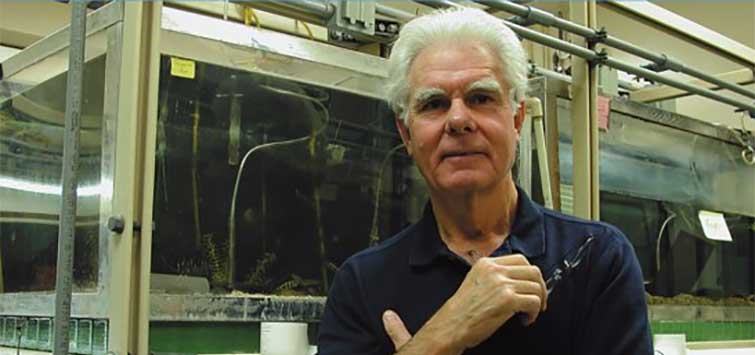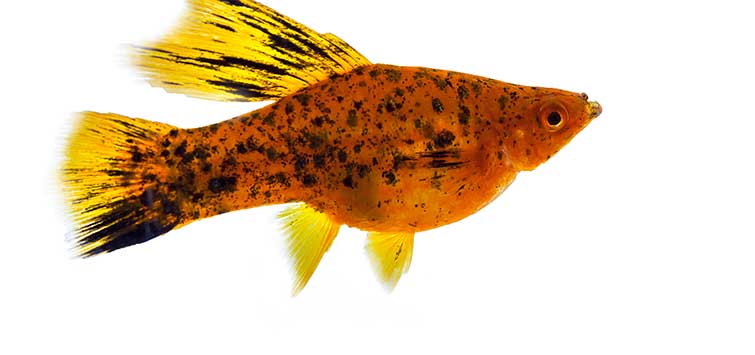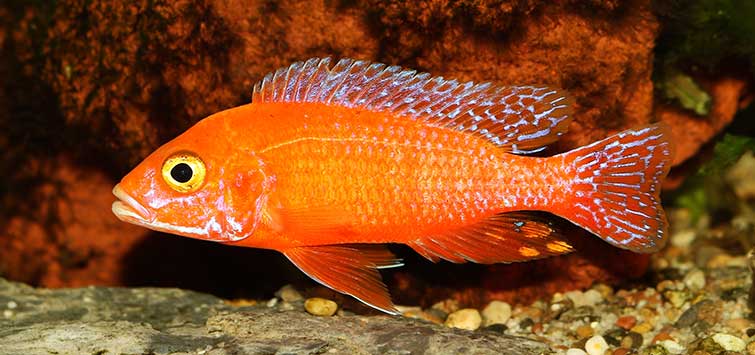Cichlidophiles: A Fond Farewell to One of Cichlidom's Greats
Author: Wayne Leibel
It was Monday morning, just days before this year’s American Cichlid Association (ACA) Convention in Sacramento, California when the Board of Trustees and the rest of the American cichlid world got the news: Dr. George W. Barlow had died suddenly and unexpectedly that Saturday, July 14 at the age of 78. The news was upsetting in and of itself, but what made all the more so was that George, a University of California Professor Emeritus who called Berkeley, California his home, was to be at this year’s convention. He was a favorite of all cichlidophiles who had the good fortune of encountering him, beginning cichlid hobbyists and seasoned cichlid academics alike. And I personally saw the chance to spend time with him again as I had at ACA conventions in 2001 (New Jersey) and 2002 (Atlanta) as one of the main attractions of attending this year’s rendition. Alas, it was not to be. Instead, I am celebrating his life here with this short essay about him.
George’s Legacy
Where to start…and where to stop…in eulogizing this great person—and I do mean the total person. If you wish, you can read an exhaustive account of his life, particularly his professional life, based on interviews with him in 2001 by professors Margaret Stewart, Ron Coleman, and W. Linn Montgomery which appeared in Copeia, the official journal of the American Society of Ichthyologists and Herpetologists, in 2004 (Copeia 2004 (4):945–951). Perhaps a better place, for the immediate time being, might be George’s own website (http://ib.berkeley.edu/labs/barlow), which I sincerely hope is preserved in cyberspace forever.
Notice I have been calling him George, whereas he actually was a PhD and Professor of Zoology and more recently Integrative Biology at the prestigious University of California at Berkeley, with enough awards and world renown for several academic careers; he was, arguably, the “Dean of Cichlids” in the academic world. Though I did befriend him (or rather, he befriended me) back in 1998, George’s preference for having everyone—both academic and hobbyist—simply call him “George” instead of “Dr. Barlow” speaks volumes about who the man was as a person. You can read about his educational pedigree and list of awards, and they are very impressive, but I will turn to George’s own account of his life (he calls it the “The Soft Version” on his website) to summarize his accomplishments and then add, from my own perspective, his many contributions to the cichlid hobby.
A Researcher, Teacher, and Friend
By George’s own account, his early life experiences shaped his career, as it often does for many of us. In his case, he was born June 15, 1929 in a small house next to the ocean in Long Beach, California and grew up on that beach, often in the water. He kept sea anemones and hermit crabs in a small bowl and fished from the dock. But racing pigeons became his passion, and he spent most of the money he made from delivering newspapers on his pigeons. He saved some, however, for his other passion—tropical fish, particularly cichlids. He went off to UCLA to become a medical doctor under parental pressure, but met an apparently charismatic professor who convinced him to become an ichthyologist instead, and he graduated with a degree in biology in 1951. The Korean War interrupted his formal education and George volunteered for the Coast Guard with the hope that this “hitch” would provide experience handling boats, which it did.
Return to UCLA
He returned to UCLA in 1953 after serving in the Central Pacific Ocean, and pursued his PhD in ichthyology, which he received in 1958 studying goby systematics. But he was drawn increasingly into the new field called “ethology,” the study of animal behavior, and he went to Bavaria for two years to study as a post-doctoral fellow in the laboratory of Konrad Lorenz, who along with Niko Tinbergen was to win a Nobel Prize for their joint pioneering work in ethology. (Later, 1973–1974, he would spend a sabbatical year with Tinbergen, the same time period in which Lorenz and Tinbergen received the Nobel Prize.)
In 1960 he returned to a faculty position as an Assistant Professor at the University of Illinois, where he navigated the tenure track for six years (he was promoted to Associate Professor in 1963), only to move onward and upward to the University of California at Berkeley, one of this country’s most prestigious academic institutions. There, he was promoted to Full Professor in the Department of Zoology in 1970 after four years of service, and he remained there for the rest of his academic career. In 1989 he shifted to the newly formed Department of Integrative Biology, where he continued to teach and research until his formal retirement in 1993. George, as Professor Emeritus, retained office and lab space in the department, and continued to write and do research on cichlids, until the time of his death.
An Aquatic Legend
These facts of his academic career–called a curriculum vitae or “CV” in academe—offer only the cold outline of a life gloriously spent watching his beloved cichlids and training a new generation of students and post-docs (including such cichlid hobby luminaries as Drs. Paul V. Loiselle and Ron Coleman). His research centered on the evolution of social behavior in fishes and the mechanisms supporting their behavior.
The kinds of fishes he investigated have ranged from desert pupfish to coral-reef fishes, but the bulk of his research was devoted to the study of cichlids. In particular, he and his students worked on the biology of aggression and mate choice in their research animal of choice, the Nicaraguan midas cichlid Amphilophus citrinellusand included both field and laboratory studies. I reviewed that work in these pages when George was made an ACA Jordan Fellow in recognition for his lifelong work with cichlids (“Wayne’s New World: ACA Honors Dr. George W. Barlow, Parts 1 and 2,” TFH April and May 1996).Even better, read George’s own account of this work in his recent popular book on cichlids (see below).
The Golden Fleece
In a funny aside, George once was awarded a “Golden Fleece” award by the late Senator William Proxmire who, in his myopic and misinformed opinion, judged George’s NSF-funded research on “Cichlid Divorce” to be a waste of taxpayer money. (Not to be confused with Alaska’s recent “Bridge to Nowhere.”) George took it all in good-humored stride. In fact, he felt honored to have his work recognized, inaccurately, that way.
A True Cichlidophile
George realized early on the symbiotic relationship that could and should exist between cichlid science and the cichlid hobby, and he promoted the conversation between the two camps whenever he could. His website has a section devoted to aquarists with links to other cichlid sites, recommendations for cichlid reading, and a very complete international list of cichlid clubs, associations, societies, and study groups.
The ACA
In fact, George was one of the founding members of the ACA, started in 1968 by a group of cichlid lovers primarily from California, including Guy D. Jordan, Dick Stratton, Paul Loiselle (then a student), and others. From the start this organization, which is still going strong (www.cichlid.org) nearly 40 years later, melded cichlid science with cichlid husbandry, each informing the other. Guy Jordan was a big fan of George’s scientific work and indeed the Guy D. Jordan Endowment of the ACA has given small grants in Guy’s name each year since its establishment in 1986. In that same year, ichthyologists Ken McKaye and Jay Stauffer, Jr. named a Malawi cichlid in George’s honor, Metriaclima barlowi.
The Cichlid Fishes
In terms of popularizing cichlids, perhaps George’s most singular and appreciated contribution to the hobby and world at large was his masterful and easily read book The Cichlid Fishes: Nature’s Grand Experiment in Evolution (Perseus Pub. 2000), the culmination and summary of his life’s work for a general audience.
Indeed, that’s how we finally met. I had known of George for years, but was so awed by the man that I never presumed to write or otherwise contact him. Little did I know how accessible and welcoming (and humble) he actually was. My own academic training was not in fish biology, but I dreamed of turning my cichlid hobby into a profession some day, and thought of how special it might be to learn from the master. In preparing his book, George emailed me (He emailed me! I printed them all out and saved them!) to ask some questions about a TFH column I had written in 1998 (“What’s In a Name? The Demonfish Jurupari,” TFH 47(2):154–157) concerning the origin of the species name ”jurupari” attached to the flagship eartheater of the genus Satanoperca. We exchanged correspondence and George even asked to use a photo of mine in his book (which he did). When the book was finally published, I gently persuaded the North Jersey Aquarium Society, sponsors of the 2001 ACA convention, to invite George to speak.
The George I Will Always Remember
George would be out at the American Society of Ichthyologists and Herpetologists annual convention the week before, that year at Penn State, and it was a short drive east to New Jersey. He came and wowed us all first and foremost with his charm and warmth and secondly as an excellent speaker with the gift of making hard cichlid science accessible to all. (In fact, we arranged to have Dick Stratton and Ross Socolof, all ACA founders and lifelong friends, attend so they could enjoy each other and the company of a fourth distinguished friend, Rosario LaCorte, who lived in Jersey.) It was there that I, and many others, fell in love with George Barlow. That he himself considered his lecture and presence at that ACA convention significant is made apparent by its entry in his CV section entitled “Invited Major Lectures in Recent Years.” Along with “Invited Opening Lecture, Behavioural Ecology of Fishes, Erice, Italy” and “Invited Keynote Lecture, Conference on the Biology of Littoral Fishes, Lisbon, Portugal” is “Invited Lecture, National Convention of the American Cichlid Association, Parsippany, New Jersey.”
He again graced us with his presence the following year at the 2002 ACA convention in Atlanta, and I have had the opportunity to spend time with him since then in my own speaking visits to California, particularly to address the Pacific Coast Cichlid Association, whose meetings he began attending with his then post-doctoral fellow, Ron Coleman. In one instance, following a talk I gave on eartheaters which George listened to intently (boy was I intimidated!), he corralled me afterwards and we talked eartheaters and mouthbrooding for an hour or more over beer.
That was George: always friendly and always wanting to learn from everyone, including—no, especially—cichlid hobbyists. Many cichlidophiles who met him at one convention or another have remarked, after his recent passing, how friendly and accessible he was to everyone, despite his illustrious academic credentials. He was simply ‘George’ to everyone he met. Humble to a fault: his website even sports a section where he solicits readers of his book to submit their corrections! And several of these appear on the site under the heading, “Whoops!”
As an external reviewer for consideration of my possible promotion to full professor, George was asked by my school’s promotion committee at my request to comment on my work, etc. The committee shared the letter with me and I cried when I read the following, the last line in a beautifully supportive letter: “I would be pleased to have him as a colleague.” My only regret: that I never got the chance to be one, particularly as his student. Oh yes, I got the promotion, and an endowed chair, thanks in large part to him.
Thank you, George...for everything. We in the cichlid world—science and hobby both—will miss you terribly. In the meantime, we are left with wonderful memories of a gentle and humble man who advanced both the science and home husbandry of cichlids. The homepage of his website is graced by a photo of George in khaki field garb, hiking boots, and a floppy expedition hat with his hand to his head, peering off into the distance, his long lean figure posed as if walking into new uncharted territory. All the cichlidophiles that knew him, myself included, wish him well in his newest adventure, wherever that might be.
See the full article on TFH Digital http://www.tfhdigital.com/tfh/200711/#pg42

.png?h=595&iar=0&w=2781&hash=5FD5E69473BCC22199FBFA2FB71B6033)



